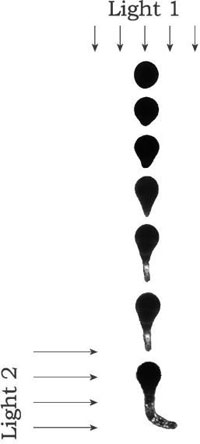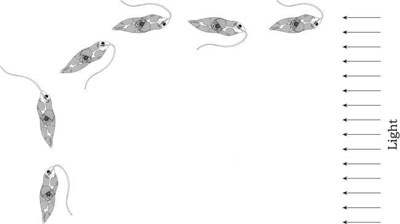Noise
- The dark noise is the noise inherent in a receptor, constant and independent of light level. It arises from the random thermal motions of the molecules.
- The photon noise (also known as shot noise) is due to the quantic nature of the light stimulus and to the resulting statistical fluctuation in the capture of a photon. This noise can be accurately estimated as the square root of the number of photons captured.
- The response noise leads to random variations in the locomotory response of the microorganism. Response noise can be further divided into motor noise, in which variations occur in locomotion from one time to another in an individual; and developmental noise, in which variations occur between individuals, as a bias to turn toward one side.
- The environmental noise consists in extraneous signal arising from sources other than those of the light signal.
In the absence of true signal (i.e., the signal is only the noise component and S/N = 1) the only strategy available is pure guessing, but the detector could guess in same way, for example, the signal is present or the signal is absent, or choose some other combinations. If a unequivocal true signal is available (S/N > 1000), a correct decision can always be made. For ambiguous signals (S/N ≈ 10), right decisions are approximately 70%.
The light stimulus (S) that maximizes information transmission is intrinsically random and has a root-mean-square deviation of standard deviation S1/2. As we have seen before, 100 photons are the true light signal in the sunniest day for the photoreceptor and 10 photons are the standard deviation of this signal (ten and three, respectively, in a cloudy day). So the light intensity level can oscillate from 110 to 90 photons (13 and 7 in a cloudy day). We can assume that the dark noise level (N, with a standard deviation of N1/2) is about zero when a rhodopsin-like protein, with the chemical–physical properties described earlier, is used as photoreceptive molecule. So the dark intensity level is about zero. Detection theory states that the two intensity levels must differ by 2N1/2 to be distinguishable with the 95% reliability.
On the basis of what we have said and, once calculated, the number of photons in the sunniest and cloudy days, we can state that the simplest photoreceptor system of most algae could recognize light from dark even in a cloudy day. Theory allows us to understand howone photon cell-1 sec-1 can actually lead to a persistent orientation in Chlamydomonas photon and is able to elicit an algae response.
In order to determine the direction of a light source, an alga must possess both a light detector and a light screen to provide directional selectivity. Such a screen can be either an absorbing element that prevents light coming from certain direction from reaching the detector or a refractive element that focuses light onto the detector only from specific directions.
Femtoplankton (0.02–0.2 µm) are too small when compared with the wavelength of light to create differential light intensity; hence, they cannot determine the direction of a light source. Still, these microorganisms can use light, but can only measure its intensity and move in a light-intensity gradient. In contrast, algae are large enough to determine light direction and move along a beam of light by scanning the environment by means of their directionally sensitive receptor.
To determine the orientation of a stimulus field, an organism has to measure the stimulus intensity at different positions. The two fundamental alternative strategies for obtaining information are:
- Parallel sampling of the stimulus by multiple separated receptors positioned on different parts of the organism surface. In this case the organism measures directly the spatial gradient by comparing the intensities at the different positions (one instant mechanism) (Figure 2.71).
- Sequential sampling of the stimulus by a single receptor that moves from one place to another. In this situation the organism measures directly a temporal gradient, and then infers the spatial gradient from the information on the movements of the receptor, (two instants mechanism) (Figure 2.72).
The simultaneous comparison of signals requires widely spaced receptors to detect intensity gradient, which makes large body size advantageous. On the other hand, sequential sampling requires a coherent pattern of movement such as locomotion in a helical path. Sequential sampling also requires some form of memory to allow the comparison with previously recorded intensities.
Phototaxis is the behavior that involves orientation in response to light stimuli that carry the information. This behavior consists in a migration oriented with respect to the stimulus direction or gradient, which is established and maintained by direct turns (phototaxis is different from phototropism. This term is frequently used for the behavior in which the organisms respond to the light response with an oriented growth). Photokinesis is the behavior that comprises undirected responses dependent on either the intensity or temporal changes in intensity of the stimulus.
Control characteristics, and thus behavioral peculiarities, are connected with the functioning of the propelling structure of the algae, that is, the flagellum. If the cell is asymmetric, it advances spinning along its axis; it can correct its trajectory by either sudden steering obtained by changing the insertion angle of flagella or stiffening of the flagellum via accessory structure of the axoneme. This behavior can be attributed to all heterokont or uniflagellate algae. In the case of a symmetric cell, it can accomplish a gradual smooth correction of its trajectory going forward without spinning (or rotating with a very long period) and displacing the barycenter of the motor couple. This behavior can be attributed to all isokont cells.
Algae are aneural organisms, lacking any system for the transmission of the stimuli received from the outside. The light signal will be first transduced in an electric signal by means of electron or ion flux, and this electric signal will be transmitted to the algae motor apparatus; in this case the flagellum using non-conventional routes are mostly unknown. PFR could represent a good candidate for such a role.






